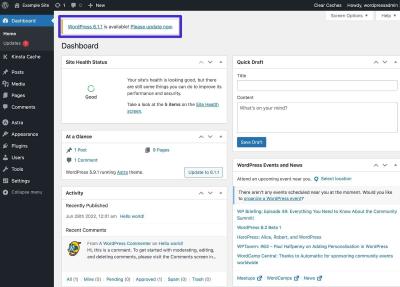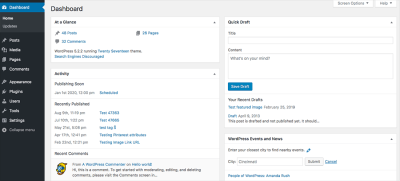Thinking about starting a blog but not sure where to begin? WordPress is one of the most popular platforms out there, and for good reason. It’s user-friendly, flexible, and packed with features that make sharing your ideas a breeze. Whether you’re a complete newbie or a seasoned writer, WordPress makes it easy to create a professional-looking blog without needing to know how to code. With countless themes and plugins, you can customize your site to reflect your personality and style. So, let’s dive into why
Benefits of Using WordPress for Your Blog
There are many reasons why bloggers love WordPress, and I’m here to share some of the biggest benefits. First off, ease of use is a game-changer. The interface is intuitive, so you can start posting content almost immediately, even if you’re not tech-savvy. Plus, WordPress offers a huge library of themes—both free and premium—that help you give your blog a stunning look without hiring a designer.
Another big advantage is flexibility. Whether you want a simple personal blog, a professional portfolio, or an e-commerce site, WordPress can handle it all with the right plugins. Want to add social media sharing buttons? There’s a plugin for that. Need to optimize your content for search engines? SEO plugins are at your fingertips.
Security is also a priority for WordPress, with regular updates and a wide range of security plugins to keep your content safe. And if you ever get stuck, the WordPress community is incredibly active and helpful—think forums, tutorials, and support groups that are ready to lend a hand.
Finally, cost-effectiveness makes WordPress a top choice. You can start a blog for free with WordPress.com, or opt for a self-hosted site with
3. How WordPress Supports Creative Expression and Idea Sharing
When it comes to sharing your ideas and expressing your creativity, WordPress truly stands out. It’s like a blank canvas that adapts to your vision, whether you’re a writer, artist, photographer, or any kind of content creator. You don’t need to be a tech wizard to get started—WordPress makes it simple and accessible for everyone.
One of the coolest things about WordPress is its flexibility. You can choose from thousands of themes that give your blog a unique look and feel. Want a minimalist design that puts your words front and center? Or maybe a bold, colorful layout that screams creativity? There’s a theme for that.
But it’s not just about visuals. WordPress offers a wealth of tools to help you share your ideas in various formats:
- Rich Text Editing: Write and format your posts easily with an intuitive editor.
- Media Integration: Upload images, videos, audio, and even embed content from other platforms to make your posts engaging.
- Custom Post Types: Beyond standard posts and pages, you can create custom content types—like portfolios, testimonials, or event listings—to showcase your work uniquely.
- Plugins for Creativity: Enhance your site with plugins that add features like galleries, sliders, maps, and more.
Plus, the open-source nature of WordPress means you’re not limited. You can modify themes, add custom code, or even develop your own plugins if you’re feeling adventurous. This openness encourages experimentation and helps your blog evolve as your ideas grow.
And let’s not forget about community support. There’s a massive community of creators, developers, and enthusiasts always ready to help you troubleshoot, share ideas, and inspire new ways to express yourself. It’s like having a built-in support system that fuels your creativity.
All these features combine to make WordPress a perfect platform for your creative expression. Whether you’re sharing personal stories, showcasing artwork, or debating ideas, WordPress adapts to your style and helps you communicate your message authentically and effectively.
4. Customizing Your WordPress Blog for Maximum Impact
Once you’ve started sharing your ideas on WordPress, the next step is making sure your blog stands out and resonates with your audience. Customization is key here—and the good news is, WordPress makes it both easy and powerful to tailor your site to your needs.
First, choose the right theme. Themes control the look and feel of your blog. Whether you want a sleek, professional appearance or something more playful and artistic, there’s a theme out there for you. Many themes are customizable with drag-and-drop editors, so you don’t need coding skills to make them your own.
Next, consider customizing your layout. Think about how visitors will navigate your content:
- Menus: Create clear navigation menus to help visitors find your most important pages.
- Widgets: Add sidebars or footer sections with widgets for recent posts, social media links, or a newsletter signup.
- Plugins: Use plugins to add new features like contact forms, SEO tools, or social sharing buttons—making your blog more interactive and discoverable.
Personal branding is also essential. Customize your site’s branding elements:
- Logo and Header Image: Upload a logo or header image that reflects your personality or brand identity.
- Color Scheme: Use colors that match your style and evoke the right emotions.
- Typography: Choose fonts that are easy to read and match your tone—formal, fun, creative, or professional.
Another powerful way to maximize impact is through SEO (Search Engine Optimization). WordPress plugins like Yoast SEO can guide you in optimizing your content, making it easier for people to find your blog when searching for related topics.
Don’t forget about responsive design. Most modern themes are mobile-friendly, ensuring your blog looks great on smartphones and tablets. This is crucial because a lot of your audience will be browsing on the go.
Finally, engage with your audience through comments, social media integration, and email newsletters. Building a community around your ideas transforms your blog from just a static site into a lively hub of conversation and inspiration.
In essence, customizing your WordPress blog isn’t just about aesthetics; it’s about creating an experience that reflects your personality, engages your readers, and amplifies your ideas. With the right tools and a bit of creativity, your blog can make a real impact and turn your ideas into a movement.
5. SEO Advantages of Using WordPress for Blogging
If you’re serious about getting your blog noticed, then understanding SEO (Search Engine Optimization) is essential. Luckily, WordPress makes this part pretty straightforward, giving you a competitive edge in search engine rankings. One of the biggest reasons WordPress stands out in the SEO world is its user-friendly structure and a wealth of built-in features that help optimize your content.
First off, WordPress generates clean, semantic code which search engines love. It helps your site load faster and makes it easier for search engines to crawl your pages effectively. Plus, there are tons of plugins—like Yoast SEO or All in One SEO Pack—that give you step-by-step guidance on optimizing each post. These tools help you focus on key elements like keywords, meta descriptions, and readability, making your content more attractive to both search engines and human visitors.
Another perk is the ability to create SEO-friendly URLs. With WordPress, you can customize your permalink structure to include relevant keywords, making your links more descriptive and easier to remember. Additionally, features like sitemap generation and schema markup support help search engines understand your content better, boosting your chances of appearing in rich snippets or featured snippets.
Content organization is also a breeze. You can categorize and tag your posts effectively, helping visitors navigate your site and find related content easily. This internal linking structure not only improves user experience but also benefits your SEO by spreading link equity throughout your site.
Here’s a quick rundown of the main SEO advantages:
- Optimized code and fast load times
- Powerful SEO plugins for detailed optimization
- Customizable URL structures
- Automatic sitemap and schema markup generation
- Easy content organization with categories and tags
All these features mean that with WordPress, you don’t have to be an SEO expert to give your blog a fighting chance in search results. It’s designed to help your ideas reach more people organically, which is ultimately what every blogger wants.
6. Engaging with Your Audience Through WordPress
Creating great content is just the first step; engaging with your audience is what transforms casual readers into loyal followers. WordPress offers a variety of tools and features that make connecting with your visitors simple and effective, turning your blog into a vibrant community hub.
One of the easiest ways to foster interaction is by enabling comments on your posts. WordPress has built-in comment functionality, allowing readers to leave their thoughts, ask questions, or share their experiences. To keep conversations respectful and spam-free, you can install plugins like Akismet or WPDiscuz, which help moderate comments and keep the discussion healthy.
Beyond comments, integrating social media sharing buttons is a smart move. WordPress plugins like AddToAny or Social Warfare make it easy to add buttons to your posts, encouraging readers to share your content across platforms like Facebook, Twitter, and LinkedIn. This not only boosts your reach but also invites more engagement and feedback.
Another fantastic feature is the ability to create interactive content. For example, you can include polls, quizzes, or surveys using plugins like WP Polls or Quiz and Survey Master. These tools make your site more lively and give your audience a way to voice their opinions, making them feel more involved.
Furthermore, building an email list is crucial for ongoing engagement. WordPress integrates seamlessly with email marketing services like Mailchimp or ConvertKit, allowing you to send newsletters, updates, or personalized content directly to your subscribers. This keeps your audience connected and eager for your next post.
Don’t forget the power of comments and feedback to improve your content. Responding to comments, asking questions, and encouraging discussion show your visitors that you value their input. Over time, this helps cultivate a community where ideas are exchanged freely, and your blog becomes a trusted space for conversation.
In summary, WordPress equips you with everything you need to build meaningful relationships with your audience. Whether it’s through comments, social sharing, interactive features, or email engagement, you can turn your blog into an active, connected community where ideas flourish.
Conclusion: Why WordPress Is the Ideal Choice for Sharing Your Ideas
Choosing the right platform to share your ideas is crucial for reaching your audience effectively. WordPress stands out as the best option due to its versatility, user-friendly interface, and extensive customization options. With thousands of themes and plugins, you can tailor your blog to match your unique voice and style, whether you’re a beginner or a seasoned blogger.
One of the key advantages of WordPress is its ease of use. Its intuitive dashboard allows you to create, edit, and publish content without any coding experience. Additionally, WordPress is highly search engine friendly, helping your ideas reach a broader audience through improved visibility on platforms like Google.
Moreover, WordPress offers comprehensive community support and a vast ecosystem of developers and users, ensuring you have assistance whenever needed. The platform also provides excellent security features and regular updates to keep your content safe.
In summary, whether you’re sharing personal insights, business ideas, or creative projects, WordPress provides the perfect foundation to grow your online presence. Its adaptability, ease of use, and supportive community make it the ideal platform for turning your ideas into impactful content that resonates with your audience.



